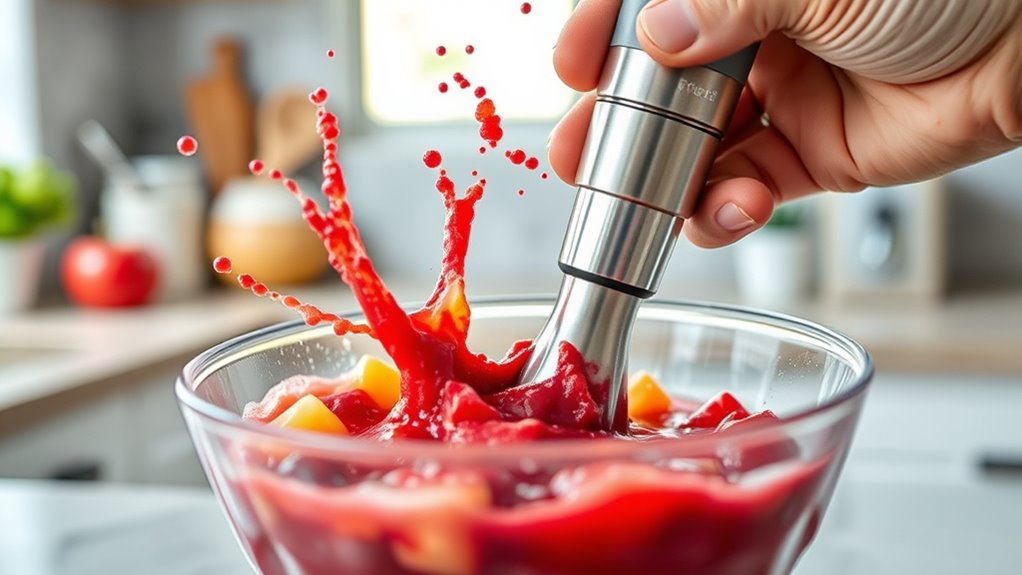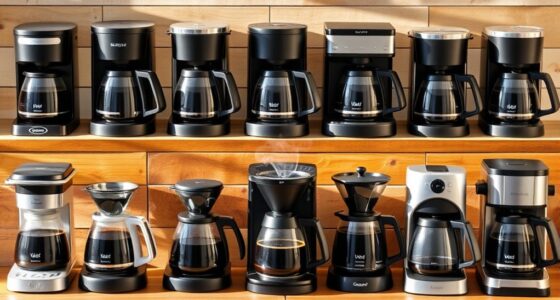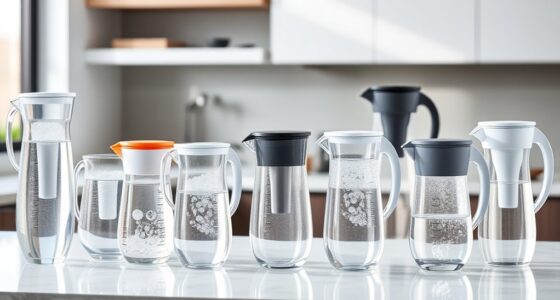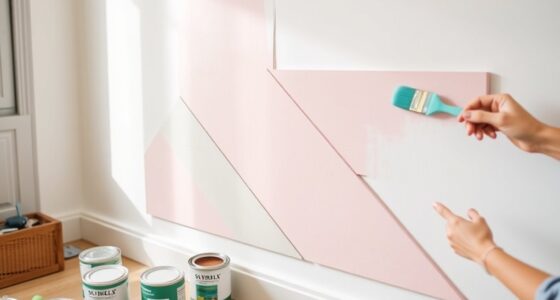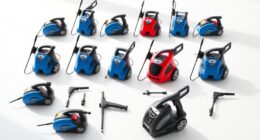To prevent splatter when using an immersion blender, make certain you use tall, narrow containers with the blades fully submerged before starting. Begin blending at low speed and gradually increase, keeping the blender at a slight tilt and moving it steadily up and down or in circles. Using splash guards or barriers can help, especially with hot liquids. Proper technique and maintenance are key—continue exploring essential tips to blend safely and effectively.
Key Takeaways
- Fully submerge the blades below the food surface before turning on to prevent splashes.
- Use tall, narrow containers and avoid overfilling to contain ingredients and reduce splatter.
- Start blending at low speed, gradually increasing to maintain control and minimize splashes.
- Keep the blender tilted slightly and move it steadily in gentle motions during operation.
- Employ splash guards or barriers, such as plastic wrap with a small hole, to catch splatters early.
Understand the Importance of Container Choice
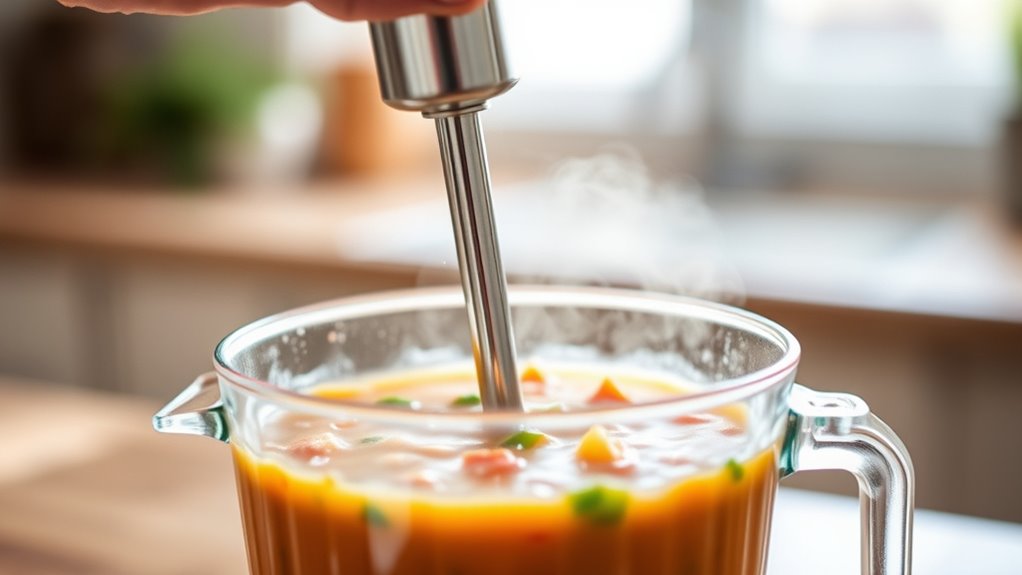
Choosing the right container is essential for safe and efficient immersion blending. Your container choice directly impacts how smoothly your immersion blender operates and helps prevent messes. Use tall, narrow containers to keep ingredients contained, reducing splashes. Deep pots are ideal for thick or liquid foods, preventing spills over the sides. Opt for containers with straight sides, which guide the mixture downward and minimize splatter. Make sure the container is appropriately sized for your ingredients to avoid overfilling, which can cause spills and splashes during blending. Additionally, select a sturdy, non-slip container to ensure stability. This reduces the risk of tipping or slipping while blending, keeping you safe and making your task easier. Proper container choice is a key step in safe immersion blender use. Proper container selection can further enhance safety by ensuring consistent moisture levels, preventing sudden slips or accidents caused by overhydration or dryness. Being aware of blender safety tips helps maintain a secure working environment and prevents common mishaps.
Ensure Complete Submersion of the Blades
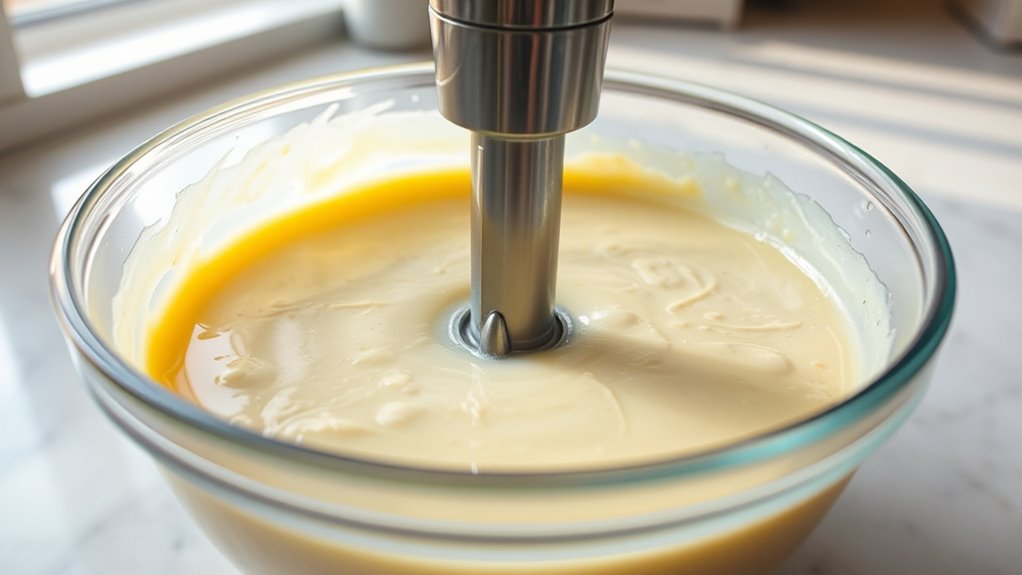
To guarantee safe and effective blending, always fully submerge the blades into the ingredients before turning on the device. Keeping the blades beneath the surface prevents splashes and hot ingredient escapes. Ensure the immersion extends at least a few inches below the container’s top for better control. Check that the entire blade assembly is submerged to avoid messes and maintain safety. When the blades are only partially immersed, splattering becomes likely, risking burns or messes. Use this quick guide to confirm proper immersion:
| Step | Action | Result |
|---|---|---|
| Check the blades | Fully submerge before turning on | Minimize splatter, improve control |
| Maintain depth | Keep blades a few inches below surface | Prevent splashes and spills |
| Verify immersion | Ensure entire blades are submerged | Safe, effective blending |
Additionally, inspecting the filter indicators on your air purifier can help ensure optimal performance and safety during maintenance. Proper tuning of your vehicle can also enhance overall safety and efficiency during operation. Regularly cleaning your blender’s blades and container also contributes to safer operation and better results, aligning with general appliance maintenance best practices. Moreover, taking the time to read the user manual can provide additional safety tips specific to your blender model. Proper safety precautions should always be followed to prevent accidents and ensure longevity of your appliance.
Use Appropriate Speed Settings and Start Slowly
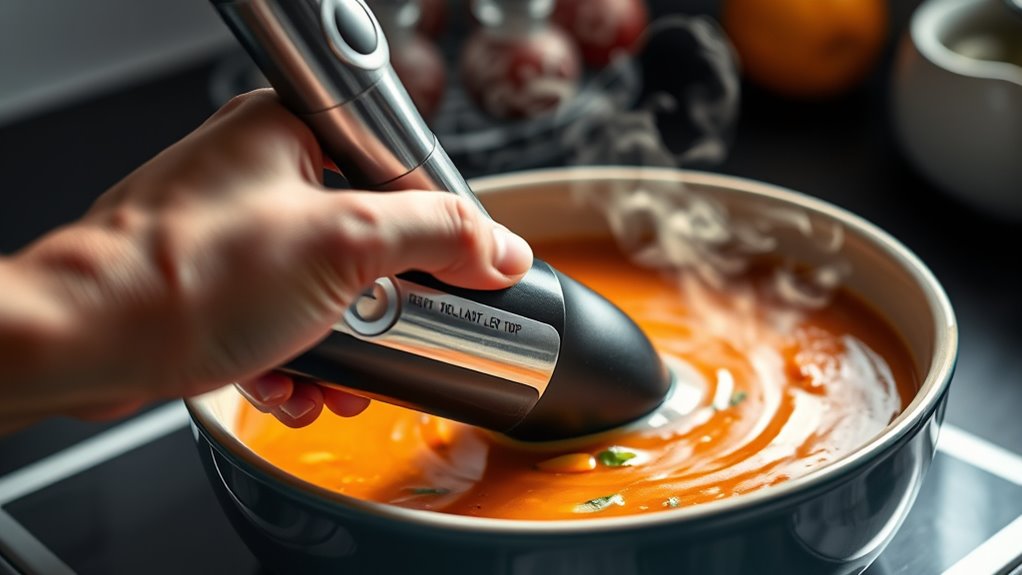
Starting your blending process at a slow speed is essential for safety and control. It helps prevent splashes and keeps ingredients from ejecting unexpectedly. To do this effectively:
Begin blending slowly for safety, control, and to prevent splashes or ejections.
- Begin with slow initial speeds to minimize splattering.
- Keep the blender at an angle to maintain control and avoid splatter from sudden movement.
- Gradually increase the speed as the ingredients start to blend smoothly, reducing the risk of splatters.
- Ensuring the proper tip size is used can also improve control and reduce splatter during blending.
- Being aware of the emotional support needs of children during family changes can help create a calm environment, which is especially important if your family is experiencing a divorce or other transition.
Using slow initial speeds allows you to observe how ingredients combine and adjust the speed as needed. Jumping straight to high settings can cause messes and potential safety hazards. Always start slowly, especially when blending thick or liquid ingredients, and increase speed gradually to keep your process safe and clean.
Incorporate Splash Guards or Barriers

Using splash guards or barriers can substantially reduce messes during immersion blending. You can use commercial splash guards designed for blenders that fit securely over containers, preventing ingredients from escaping. Alternatively, a homemade barrier, like plastic wrap with a small hole or parchment paper, works well; cut a tiny opening so the blender shaft passes through while blocking larger splashes. Positioning a barrier just above the food helps catch splatters before they reach your countertops or walls, keeping your workspace cleaner. Combining the use of splash guards with proper blending techniques further minimizes splatter. These simple precautions make cleanup easier and enhance safety by preventing unexpected splashes, letting you focus on your recipe without worrying about a messy kitchen. Incorporating space and organization strategies, such as designated zones or multi-functional tools, can also streamline your prep and cleanup process. Additionally, being aware of entertainment support hours can help you plan your cooking sessions during less busy times, reducing distractions and allowing you to focus on your safety measures. Proper equipment maintenance ensures your immersion blender operates efficiently and reduces the risk of malfunctions that could cause splattering.
Maintain Proper Angle and Movement During Blending

Hold the blender at a slight angle to direct the mixture downward and reduce splashes. Use gentle, up-and-down motions to guarantee even blending and prevent sudden splatters. Keep the blades fully submerged and move the blender continuously to avoid hotspots and splashes. Additionally, ensure that you use the appropriate gadget maintenance to keep the blades sharp and functioning properly. Proper cleaning procedures also help maintain optimal blade performance and prevent residue buildup that can cause uneven blending. Regularly inspecting and replacing worn blades can further enhance safety and efficiency during use.
Keep Blender Slightly Tilted
To blend safely and effectively, keep the immersion blender tilted at about 10 to 15 degrees. This slight angle directs the mixture downward, reducing splashing and keeping the blades fully submerged. To maximize control and minimize mess, follow these tips:
- Maintain a slight angle to prevent ingredients from escaping the container.
- Move the immersion blender in gentle, up-and-down motions to ensure even blending.
- Adjust the tilt as needed to keep the blades submerged and avoid sudden splashes.
- Being aware of the preservation efforts in historic sites can help you better understand the importance of maintaining your equipment to prevent accidents.
Using a slight angle when operating your immersion blenders helps you stay in control, requiring less force and reducing the risk of splatter. Consistently keeping the blender tilted ensures a cleaner workspace and more efficient blending process.
Use Up-and-Down Motions
Maintaining a steady up-and-down motion while blending helps you control the immersion blender and achieve even results. Use gentle, consistent movements to guarantee the blades fully immerse in the ingredients, minimizing splashes. Keep the blender at a slight angle to direct the mixture downward, reducing splatter. Always move the blender vertically through the mixture, which promotes uniform blending and prevents localized splatters. As the mixture thickens, adjust your motion gradually to maintain control and avoid sudden splashes. Avoid vigorous or erratic movements that might cause ingredients to escape or splatter. By focusing on smooth, controlled up-and-down motions and keeping the blades fully submerged, you’ll blend safely and efficiently while preventing messes. This technique ensures a safer, cleaner blending experience. Incorporating proper technique and cost-effective strategies from asset division can also help you budget wisely for kitchen tools and accessories, ensuring safety without overspending. Additionally, practicing proper technique enhances overall safety, reducing the risk of accidents during operation.
Maintain Submersion Throughout
Keeping the immersion blender properly submerged is essential for safe and effective blending. To maintain submersion and prevent splatters, follow these guidelines:
- Always keep the blender at a slight angle to direct the mixture downward, reducing outward spray.
- Move the blender in gentle, steady motions—up-and-down or circular—to ensure even blending.
- Continuously adjust the angle and position to keep the blades beneath the surface, avoiding exposure that causes splattering.
Avoid Overfilling the Container

Overfilling the container can lead to ingredients spilling over during blending, creating a mess and increasing safety risks. When you overfill, ingredients have nowhere to go, causing splashes or spillages that can make your workspace slippery or messy. To prevent this, fill the container only up to two-thirds full, giving enough space for ingredients to move freely. Excessively full containers also heighten the risk of hot liquids splattering, which can cause burns or injuries. Using a tall, large enough container helps contain ingredients and limits spillage when blending. Always follow the manufacturer’s recommended maximum fill line to avoid overfilling and ensure safe operation. Keeping the container properly filled minimizes the chances of a spill and keeps your blending process safe. Additionally, understanding the importance of remote work productivity can help you create a more efficient and safe kitchen environment by reducing distractions and promoting focus during food preparation.
Keep the Blender Moving for Even Results
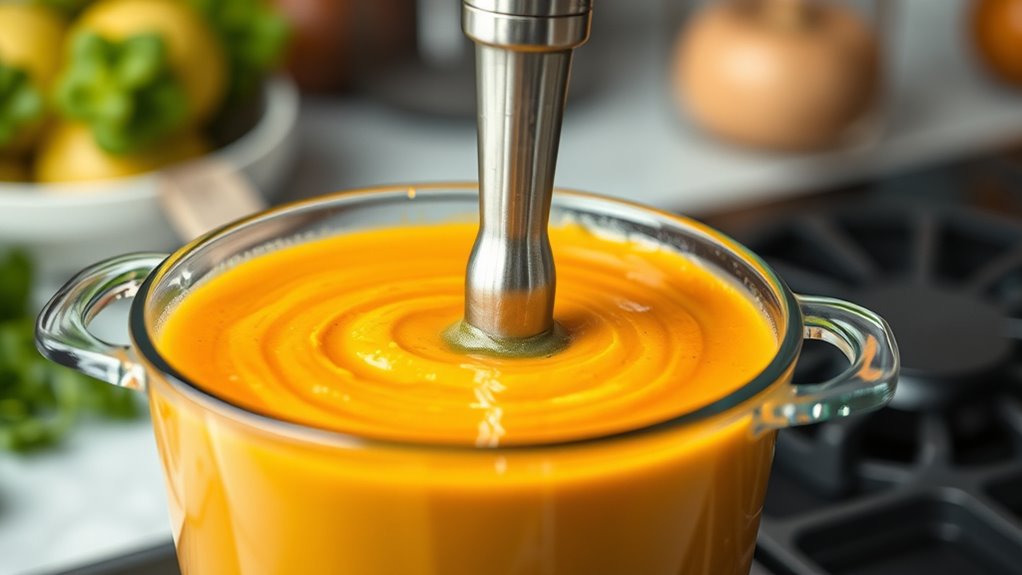
To achieve consistently smooth, even blends, it’s essential to keep the immersion blender moving steadily throughout the process. This helps prevent food from accumulating in one spot, reducing splatter and ensuring even results. To do this effectively:
- Use gentle, circular motions to blend ingredients smoothly.
- Move the blender upward and downward to avoid splashing out of the container.
- Maintain a steady pace to prevent creating a vortex that could cause splatter.
Keeping the blender moving not only promotes uniform blending but also gives you more control, especially with thicker or turbulent mixtures. Remember, the key is to keep the blender moving constantly—this simple step makes a big difference in achieving even results and avoiding messes.
Be Cautious When Blending Hot Liquids
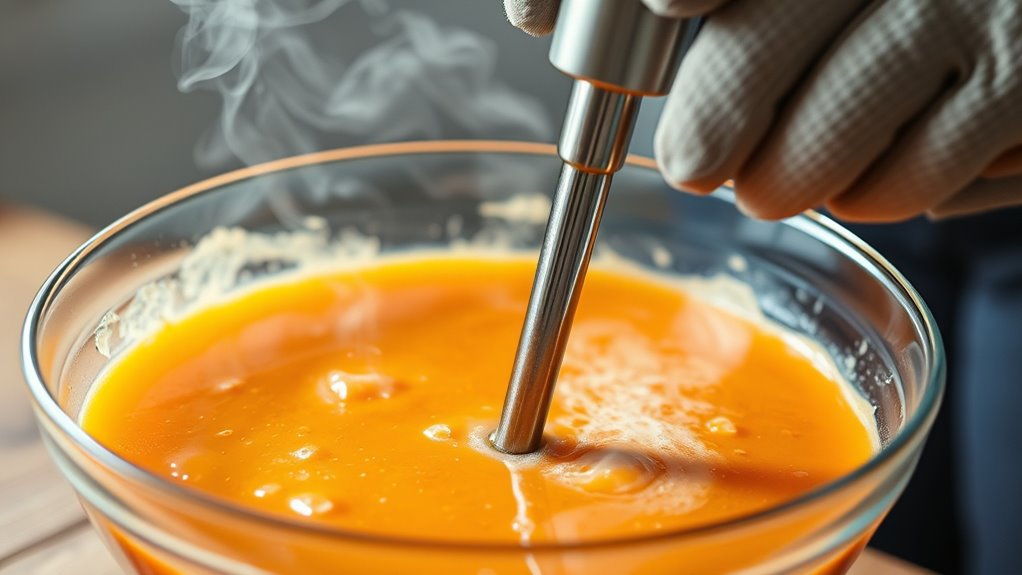
Blending hot liquids requires extra caution because the high temperature increases the risk of splashes and burns. Always fully immerse the blender blades below the hot liquid’s surface before turning it on to prevent dangerous splatters. Start blending at a low speed and gradually increase to control splattering. Use a tall, narrow container to contain the hot liquids and minimize spillover. Keep the blender at a slight angle to direct the mixture downward, reducing outward splashes. Allow the hot liquids to cool slightly before blending to decrease steam and pressure buildup that can cause splattering. Following these precautions helps keep you safe and prevents messy accidents when working with hot liquids. Remember, patience and careful technique are key to safe blending.
Regularly Inspect and Maintain Your Blender

Regularly inspecting your immersion blender is essential to guarantee safe and effective operation. Conducting routine inspection and maintenance helps identify potential issues before they cause malfunctions or safety hazards. Here are three key steps:
- Check the power cord, plug, and blades for signs of wear, damage, or fraying before each use.
- Ensure all detachable parts are clean, dry, and securely assembled to prevent leaks or malfunctions.
- Inspect the housing for cracks or corrosion that could compromise safety during operation.
Perform any necessary maintenance, such as replacing worn blades or filters, following the manufacturer’s guidelines. Always unplug the blender before cleaning or maintenance to avoid accidental activation. Proper inspection and maintenance keep your immersion blender safe and functioning as effectively as possible.
Follow Manufacturer Safety Guidelines
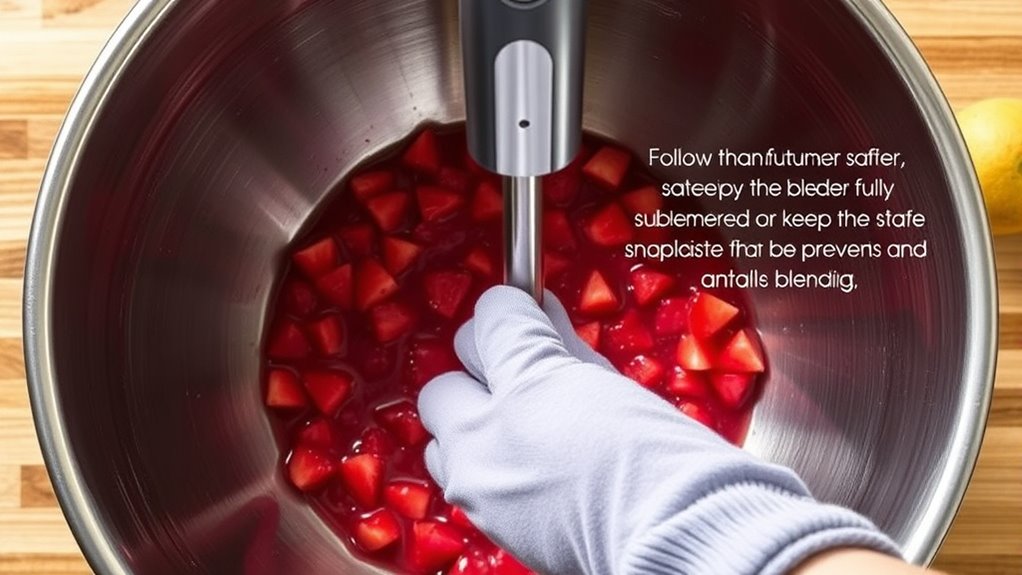
Following the manufacturer’s safety guidelines is essential for preventing accidents and ensuring your immersion blender operates correctly. Always read the user manual thoroughly before use to understand safety instructions. Adhere to recommended maximum immersion depth and container sizes to prevent splashes and damage. Use safety certifications like UL or ETL marks to confirm the device meets safety standards. Follow guidelines for cleaning, maintenance, and inspection to avoid hazards caused by damaged parts. Pay attention to warning labels and notices included with your blender. Remember, blades are fully enclosed during operation, so follow manufacturer safety guidelines to keep yourself safe. Proper use reduces risks and prolongs your blender’s lifespan.
| Safety Tip | Why it Matters |
|---|---|
| Follow manufacturer safety guidelines | Prevents accidents and damage |
| Read the user manual thoroughly | Understand specific safety instructions |
| Use safety-certified devices | Ensures device meets safety standards |
| Keep blades fully enclosed during use | Avoid injury and splatter |
| Inspect and maintain regularly | Detects damage early and prevents hazards |
Frequently Asked Questions
How to Keep Immersion Blender From Splattering?
To prevent splattering with your immersion blender, make certain you fully submerge the blades before turning it on. Start blending at the lowest speed and gradually increase. Use a tall, narrow container to contain ingredients and keep the blender at a slight angle, directing the mixture downward. Move it gently in up-and-down motions, maintaining control to avoid messy splashes and ensure a smooth blend.
What Are the Safety Precautions for Immersion Blenders?
When using an immersion blender, you should always unplug it before cleaning or handling the blades to avoid accidents. Make sure to fully immerse the blades in ingredients before turning it on to prevent splashes. Regularly check the cord and plug for damage, and keep the cord away from hot surfaces and water. Follow the manufacturer’s instructions to stay safe and maintain your blender properly.
How to Not Make a Mess With an Immersion Blender?
To avoid making a mess with your immersion blender, use a tall, narrow container to contain splashes. Fully submerge the blades before turning it on, and start blending at a low speed. Hold the blender at a slight angle, moving it gently up and down to keep the mixture directed downward. This way, you maintain control and minimize splatter, keeping your workspace clean and mess-free.
Why Does My Immersion Blender Make a Mess?
You might think your immersion blender makes a mess because it’s faulty, but usually it’s because of how you use it. When you start blending in a shallow container or with hot liquids, splatter happens. Also, if you don’t fully immerse the blades or start at high speed immediately, ingredients can escape. To avoid this, keep the blades submerged, use a tall, narrow container, and start at low speed.
Conclusion
Remember, mastering immersion blender safety is like wielding a wizard’s wand—precision and caution are key. By choosing the right container, controlling speed, and respecting hot liquids, you prevent splatters and mishaps. Keep your movements steady, and follow safety guidelines, just as a skilled sorcerer respects their spellbook. With care and attention, you’ll blend with confidence, turning chaos into culinary magic—no splatters, just smooth, delicious results.
